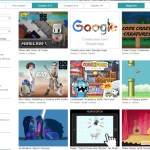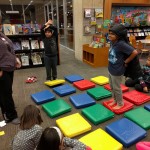As part of our commitment to digital literacy, Skokie Public Library began offering a drop-in, one-hour coding program twice a month for kids in grades 3-5. The program is intended to expose kids to coding concepts and resources readily available in the library, and to help them create a community of practice where, regardless of skill level, kids are able to help and be helped by peers. We have two main facilitators for the program and host this out in the open of the Youth Department–all the better to attract curious kids who just happen to be in the library on a Monday night.
The coding program features a variety of either free coding resources, like Hour of Code or Scratch; or we use this program setting to highlight library tech resources like Ozobot Bits that are available in the youth computer lab. Facilitators provide an overview of the featured resource and activity and implement challenges that can scale up or down depending on participants’ skill levels. Participants are encouraged to help each other and create their own challenges.
In the first two months of offering this program, we experimented with digital and analog activities within each session. We began by introducing participants to the concept of coding, asking them if they have heard of the term before and what they thought it meant. We then had them access Hour of Code activities on Chromebooks. Some participants were familiar with Hour of Code and coding basics and had no trouble selecting their tutorial for the session, while others needed more guidance. We encouraged participants to use the filters for choosing an activity and to focus on block coding tutorials.
As kids worked through their chosen tutorials, we talked about what we were learning, shared questions, and helped each other problem solve. This model worked well for about half the session, and then we noticed participants were demonstrating a need to be off a screen. So we introduced Uno and played a few rounds, talking about how the card game, with its clear order and rules, has similarities to the coding tutorials from Hour of Code and coding in general.
After two months of featuring Hour of Code, we moved on to use our Ozobot Bit classroom set. The first session introduced participants to Ozoblockly, the online editor, while the second session used markers to draw codes. Both sessions presented participants with different coding challenges, including some provided by Ozobot.
As we made final plans for this month’s activities, one of our local school districts reached out about the coding program. The school wanted to promote our program as part of their Computer Science Education Week lineup. In anticipation of a larger crowd of kids (we’d been averaging 3-7 each session), we went completely analog for December. We started the session by using Table Top Coding, a resource created by Amy Koester and featured on WisCode Literati. Participants used code written on index cards to move chess and checker pieces. They took turns “playing” a code and were eager to help each other complete the challenges. After a few rounds of Table Top Coding, we built upon this activity by creating a lifesize grid with storytime pillow seats. Participants coded each other to retrieve a token that had been hidden underneath one of the pillows. Both of these activities encouraged kids to grasp the concept of the x/y axis grid that is a component of so many visual coding interfaces, which we’ll be exploring next.
Without the use of technology, this activity emphasized computational thinking elements in a physically active way. The format allowed facilitators to talk about how computers are coded to do specific tasks in specific languages and how algorithms can be developed to execute tasks efficiently. The conversations that kids had as they moved around and “coded” one another really seemed to do the trick with regard to learning and confidence. With everyone working together to provide discrete coding instructions to achieve our group task, kids were reinforcing core concepts to one another, helping each other to troubleshoot, and overall cheering each other on.






Leave A Comment